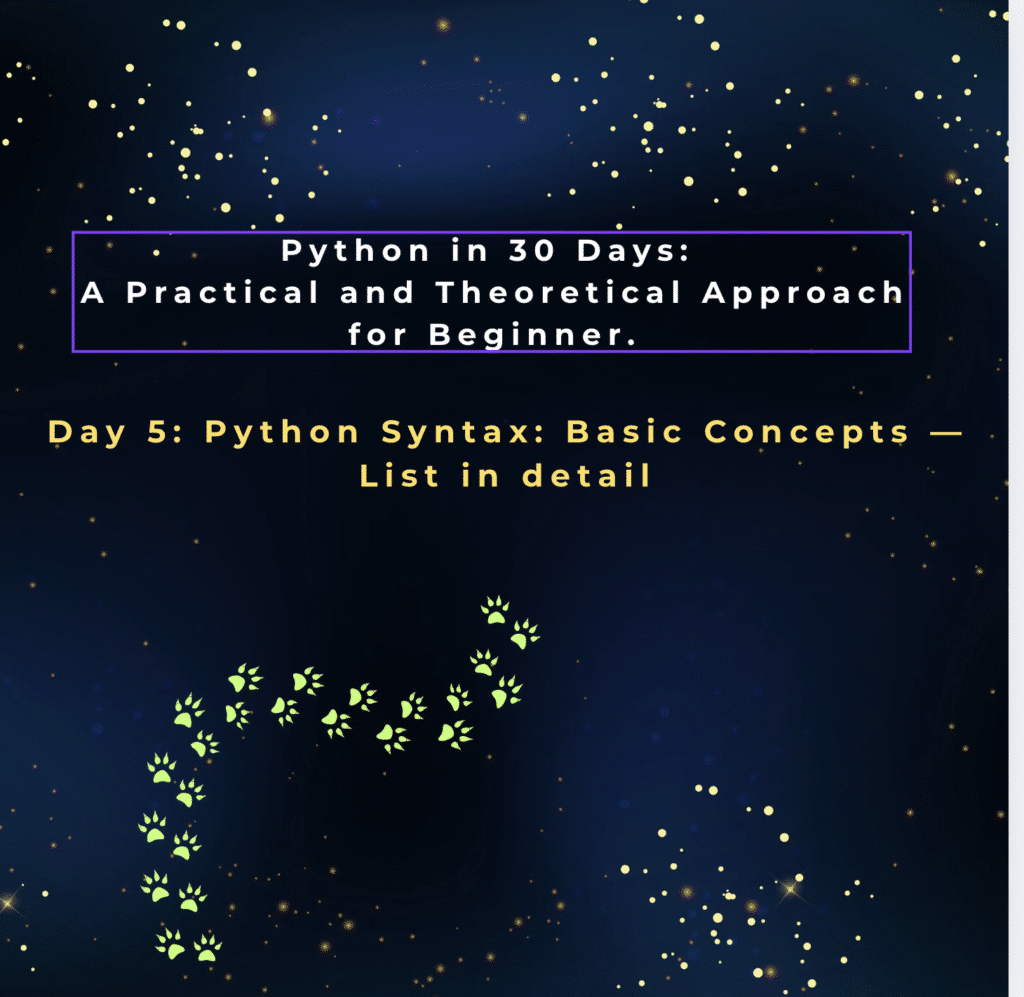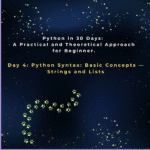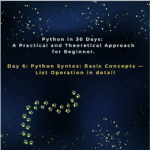Python in 30 Days: A Practical and Theoretical Approach for Beginner.
A list is one of the most commonly used data structures in Python.

- It is a collection of ordered, mutable (changeable), and heterogeneous elements.
- Lists allow you to store multiple items in a single variable.
- Lists are defined by square brackets
[].
Characteristics of Lists:
- Ordered: The items in a list have a specific order, and this order is maintained.
- Mutable: You can change the elements in a list (add, remove, modify).
- Heterogeneous: A list can store elements of different data types (e.g., integers, strings, or even other lists).
SYNTAX
list_name = [element1, element2, element3, ...]Example of List in Python
Creating a List
# Creating a List
fruits = ["apple", "banana", "cherry", "orange"]Accessing elements by index (starting from 0)
print(fruits[0]) # Output: apple
print(fruits[2]) # Output: cherryNegative indexing (accessing from the end of the list)
print(fruits[-1]) # Output: orange
print(fruits[-2]) # Output: cherrySlicing a list
print(fruits[1:3])
#Output: ['banana', 'cherry'] (items at index 1 and 2)Modifying an element in the list
fruits[1] = "blueberry"
print(fruits)
#Output: ['apple', 'blueberry', 'cherry', 'orange']Adding an element to the list using append()
fruits.append("grape")
print(fruits)
#Output : ['apple', 'blueberry', 'cherry', 'orange', 'grape']Inserting an element at a specific position
fruits.insert(2, "kiwi")
print(fruits)
# Output: ['apple', 'blueberry', 'kiwi', 'cherry', 'orange', 'grape'];Removing an element from the list
fruits.remove("cherry")
print(fruits)
# Output: ['apple', 'blueberry', 'kiwi', 'orange', 'grape']Popping an element (removes the last item by default)
# Popping an element (removes the last item by default)
popped_item = fruits.pop()
print(popped_item) # Output: grape
print(fruits)
# Output: ['apple', 'blueberry', 'kiwi', 'orange']Length of the list
# Length of the list
print(len(fruits))
# Output: 4Check if an item exists in the list
# Check if an item exists in the list
print("kiwi" in fruits)
# Output: True
print("mango" in fruits)
# Output: FalseLists in Python are versatile and easy to use.
They are the go-to structure for many tasks, such as storing and manipulating collections of data.
We can easily access, modify, and perform operations like appending, inserting, and removing elements with just a few lines of code.
Happy Coding and Stay Tuned 🙂
Kind is always cool !!!
Share knowledge to gain knowledge !!!!
Be kind and treat people with respect !!!
If you find my blog helpful, then please subscribe, claps and follow to support 🙂
Physics Made Easy: Disadvantages of Newton’s Second Law (Day 11)
🤔 Are…
✅ Physics Made Easy: Advantages of Newton’s Second Law (Day 10)
🌟 Why…
⚙️ Physics Made Easy: How Force, Mass, and Acceleration Work Together (Day 9)
🔄 The…
Physics Made Easy: Newton’s Second Law – Deriving the Formula (Day 8)
🔬 What…
Physics Made Easy: Real-Life Examples of Newton’s Second Law (Day 7)
🧪 Quick…
Physics Made Easy: Newton’s Second Law (Day 6)
Introduction Have…








